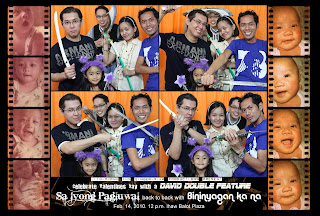 Paano Na Kaya is a cotton candy dipped in honey and sprinkled with confectioner's sugar. It is that diabetically sweet yet matabang pa rin. Sobrang dami na ng hinalo sa kanya upang maging masarap pero bland pa rin ang lasa niya. Parang Kare-kareng walang bagoong. Parang Halo-halo na walang gatas.
Paano Na Kaya is a cotton candy dipped in honey and sprinkled with confectioner's sugar. It is that diabetically sweet yet matabang pa rin. Sobrang dami na ng hinalo sa kanya upang maging masarap pero bland pa rin ang lasa niya. Parang Kare-kareng walang bagoong. Parang Halo-halo na walang gatas.To begin with, artificial ang dating ng pagka-"mature" ng characters nina Gerald Anderson at Kim Chui. Despite their projections and looks, mukha pa rin silang mga teenagers na naglalaro ng bahay-bahayan at nagpapa-cute sa isa't-isa. Modulated ang boses ni Gerald at nagshi-shriek pa rin ang kay Kim.
Second is the movie feels like a hodgepodge of everything Star Cinema. It feels like they put their hands into a box of story elements so they can create a new story. Ang kinalabasan ay isa lang siyang copycat at walang sariling identity.
The concept itself of best friends falling in love with each other reminds us of the Jolina Magdangal-Marvin Agustin starrer, Labs Kita, Okey Ka Lang? Yes, di na naman bago ang kuwentong nai-in love ang mag-best friends sa isa't-isa but still, parang second fiddle pa rin sila sa naturang pelikula.
The teasing towel scene of Bogs (Gerald) where he pretends to take off his towel in front of Mae (Kim) is reminscent of the Judy Ann Santos-Rico Yan movie, Paano Ang Puso Ko. That scene was cute kasi may halong innocence ang karakter ni Juday, PNK's is annoying. Mag-iinarte si Mae ng ganu'n samantalang pinapayagan niyang maligo si Bogs sa banyo ng kwarto niya! In the said movie, Juday is best friends with Wowie de Guzman. Wowie is in love with Juday, but Juday's heart is set on Rico.
 This particular car scene could've been taken from Claudine Barreto-Rico Yan's Got To Believe. It was when Rico was telling Claudine on how to behave like a woman. Claudine sleeps on top of the car while Rico, who is starting to fall in love with her, just stares at her.
This particular car scene could've been taken from Claudine Barreto-Rico Yan's Got To Believe. It was when Rico was telling Claudine on how to behave like a woman. Claudine sleeps on top of the car while Rico, who is starting to fall in love with her, just stares at her.There is also another scene where Mae is watching Kung Ako Na Lang Sana with Sharon Cuneta and Aga Muhlach. Again, it's a movie about Sharon falling in love with her best friend, Aga, who eventually falls for her.
I am not sure if Paano Na Kaya pays homage to the aforementioned movies. If it does, then fine. Sana lang ay naging maganda at maayos ang naging atake nila about it at hindi mga simpleng copycats lang.
Isa rin na hindi maalis sa mga Star Cinema movies ay ang issue ng lead character with his/her father. Palaging may mga gusto siyang patunayan sa kanyang ama who only thinks of him/her as second best sa mga kapatid niya.
In this movie, it is Mae who struggles to prove herself to her father. She owns a clothing company, but gives it up to attend to their family business when her sister got married. Dito na rin uminog ang kuwento dahil hanggang kay Bogs, second best lang ang tingin niya sa kanyang sarili.
Two recent Star Cinema movies that dealt with such family issues were A Very Special Love (with sequel You Changed My Life) and For the First Time. (Pati ang pinakabagong Miss You Like Crazy ay may tema rin ng pagiging second priority.)
Just recently I saw Mark Anthony Fernandez and Claudine Barreto's Mangarap Ka on Cinema One. Mark has same issues with his father. This movie was from the '90s.
So, bakit palaging ganu'n? Wala na bang ibang plot na pwedeng gamitin as motivating factors for different characters? Nagkakataon lang ba ang pagkakapare-pareho o wala ng maisip na iba?
In terms of the lead characters' love story, Philbert Dy of Click the City used the term "love by default." I agree with him dahil from the beginning of the film, we should expect na in love na si best friend sa kanyang best friend. Hindi na natin dapat kuwestiyunin 'yun. It didn't bother to establish the kind of friendship they have and why is Mae so in love with Bogs. Ang ipinakita na kaagad ay ang pagiging alalay at sunud-sunuran ni Mae kay Bogs to the point na rito na umikot ang mundo niya--leaving work just so she can attend to his needs. Sabi nga ni Mae, ang taong nagmamahal ay tanga.
When she finally tells him she loves him after his break-up with his girlfriend, Bogs, in drunken state, tells her na sila na lang. Mae immediately jumps at the opportunity! Dahil nga, ang taong nagmamahal, hindi lang tanga, desperado pa! Walang dignidad na tinitira para sa sarili.
Things start to go well with the relationship at first. Dangan nga lang ay may mga kaibigang duda sa kanilang relasyon. Itong mga kaibigan na ito ay walang ibang magawa sa buhay kundi sundan ang love story nilang dalawa. (Tulad ng mga kaibigan ni Laida sa You Changed My Life.) Bukod pa ru'n ay nagpaparamdam uli si ex-gf at nakikipagkaibigan kay Bogs. Nu'ng makita ni Mae ang attempt ni ex-gf na halikan si Bogs, dito na nawala ang kwento.
Mae runs away. Bogs runs after her. Then Mae tells Bogs how insignificant she feels. Na she has every right to get jealous. Na sobra niyang tinututukan si Bogs dahil insecure siya sa sarili niya. Sa parteng ito, parang nagkaru'n ng lapse! Nagbabanggit si Mae ng mga bagay-bagay na di naman ipinakita sa pelikula. She has never acted jealous of the ex. Di niya nina-nag si Bogs sa whereabouts nito. Di niya ipinakitang insecure siya kailanman. Di siya gumawa ng demands kay Bogs. Same Mae pa rin siya as before kahit mag-syota na sila ni best friend. Tapos suddenly, maglilinya siya ng mga ganu'ng bagay? (Ito ang pinagmulan ng eksena kung saan sasabihin ni Mae na shinota siya ni Bogs. "Shinota mo ang best friend mo!")
Hindi naipakita sa actions ang narrative ng pelikula. All dialogues ito at sandamakmak na luha from Mae. Parang lahat ng mga sinasabi nila ay nasa back story lang that we never get to see. Kaya sino ba naman ang hindi mawiwindang sa mga pagkakataong iyon?
Sa trailer, I admit that Paano Na Kaya appealed to me. Despite the age-old concept, I found it interesting. But looks can be deceiving. Ang sarap ng pagkain ay nasa pagtikim nito at hindi sa kanyang itsura. Sadly, Paano Na Kaya is all fluff, but no character. It centered more on the events that "needed" to be there and how the characters would react to them rather than events happening as the results of the characters behaviors toward their surroundings.
P.S.
I saw on video the Aljur Abrenica-Kris Bernal flick "Nandito Ako Nagmamahal Sa 'yo" directed by Maryo J. delos Reyes. I could easily say na mas malaman ang tambalan nila kaysa sa Kimerald in terms of acting. Mas kapani-paniwala ang maturity nila sa pelikula.
Isa nga sa nakakatuwang eksena sa pelikula ay nang matapos panoorin ng dalawa ng sinasabing legend ng Chocolote Hills--ang mga burol daw ay ang luha ng prinsipe para sa kanyang namayapang sinta. Aljur says, "Ang sweet naman. Parang Kim-Gerald."






























































